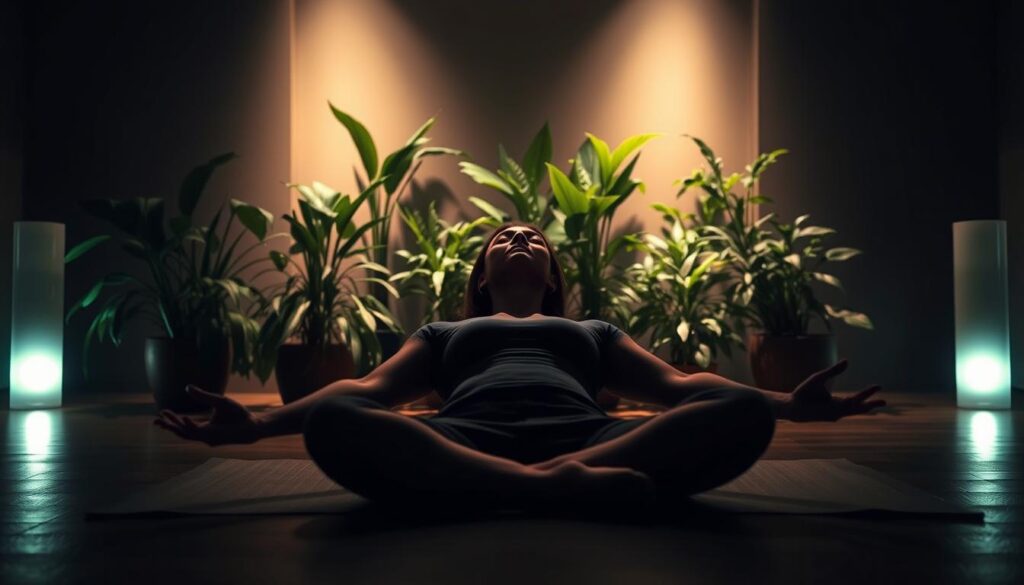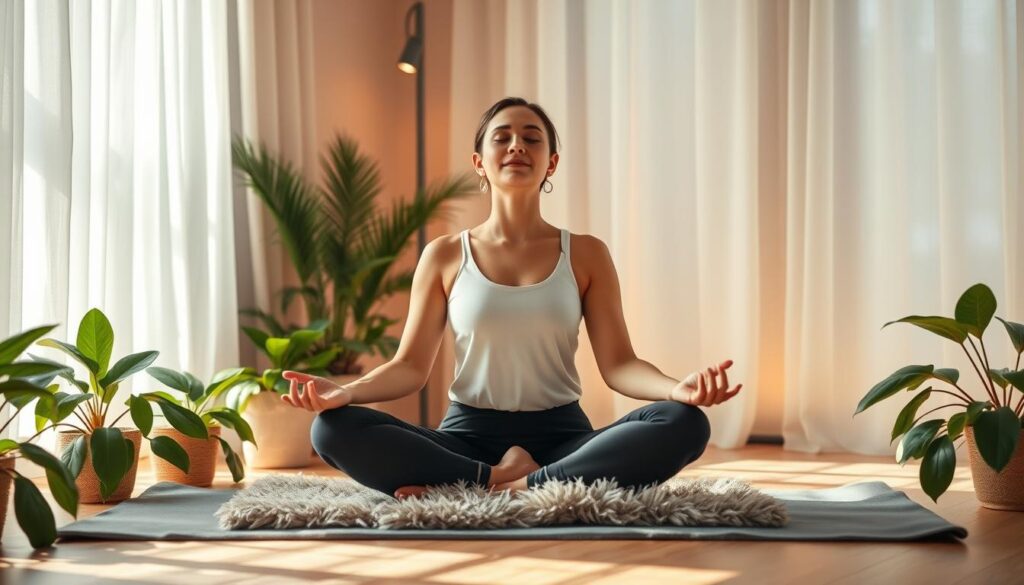
Discover the Healing Effects of Yoga Nidra
Yoga Nidra, an ancient practice known as “yogic sleep,” is a guided method of yoga nidra relaxation that promotes deep healing. Unlike traditional meditation, this technique uses yoga nidra therapy to calm the nervous system and restore balance. Modern studies show its healing effects of yoga nidra can reduce stress, improve mental clarity, and support overall wellness.

Key Takeaways
- Yoga Nidra integrates relaxation with mindful awareness to foster holistic healing.
- Its therapy techniques help manage stress and emotional challenges naturally.
- Regular practice enhances sleep quality and emotional resilience.
- Yoga nidra relaxation can be practiced by anyone, even beginners.
- Research highlights its role in improving mental and physical health.
What is Yoga Nidra?
Yoga Nidra is an ancient practice blending meditation and relaxation to unlock a state of conscious deep sleep. Rooted in tantric traditions, its origins trace back to yoga’s earliest texts, like the Upanishads. Modern systems, pioneered by Swami Satyananda Saraswati, transformed it into a structured yoga nidra meditation accessible to all.
Definition and Origins
Derived from Sanskrit, “nidra” means sleep, yet this practice keeps the mind awake during a sleep-like state. Its roots in sacred texts highlight its purpose: to harmonize body and mind. Swami Satyananda Saraswati’s 20th-century refinements made it a tool for modern wellness, emphasizing its healing effects of yoga nidra for both body and spirit.
The Practice of Yoga Nidra
A typical session follows these steps:
- Lying down comfortably, focusing on guided instructions.
- Body scanning to release tension, followed by breath awareness.
- Visualization and intention-setting to deepen awareness.
- Gradual return to full consciousness, carrying calm into daily life.
Benefits of Practicing Yoga Nidra
Regular practice offers transformative yoga nidra benefits:
- Reduces stress and anxiety through mindful relaxation.
- Enhances sleep quality and emotional balance.
- Promotes creativity and clarity through mental stillness.
Whether seeking stress relief or spiritual growth, this practice adapts to individual needs, making it a versatile path to well-being.
How Yoga Nidra Facilitates Healing
Yoga Nidra therapy uses guided deep relaxation to unlock the body’s innate ability to heal. This practice blends ancient techniques with modern wellness science to address both physical and mental health. Let’s explore how this works in everyday life.

Physical Healing Through Relaxation
- Reduces cortisol: Lower stress hormones speed wound healing and boost immunity.
- Regulates blood pressure: Calming the nervous system eases strain on heart and blood vessels.
- Activates restorative states: The healing effects of yoga nidra encourage cellular repair during the deep relaxation phase.
Chronic pain sufferers report less discomfort after regular sessions. Studies show improved digestion and better sleep cycles align with consistent practice.
Mental Clarity and Emotional Balance
“Yoga Nidra helps you observe thoughts like clouds passing in the sky—without getting stuck in them.”
By focusing on body sensations instead of mental noise, practitioners gain emotional distance from stress. This creates mental space to address challenges calmly. Yoga nidra deep relaxation also sharpens focus by quieting overwhelm, making it easier to tackle daily decisions without anxiety.
Therapists use yoga nidra therapy to help clients process trauma by safely reconnecting with emotions. The practice builds resilience against negative thought loops, fostering lasting emotional stability.
The Science Behind Yoga Nidra
Modern research confirms what practitioners have long known: yoga nidraa’s effects extend beyond feelings. Here’s how science explains its power.
Research on Yoga Nidra’s Effects
A 2022 study by the Swami Vivekananda Yoga Research Foundation found yoga nidra therapy reduced stress hormones like cortisol by 35% in chronic pain patients. Walter Reed Army Medical Center trials showed veterans practicing yoga nidraa meditation saw 40% lower anxiety scores and improved heart rate variability.
Neurobiological Mechanisms
Brain scans reveal yoga nidraa deep relaxation shifts practitioners into theta brain waves, a state linked to enhanced creativity and emotional healing. These shifts calm the amygdala (fear center) while boosting prefrontal cortex activity, fostering lasting neuroplastic changes that improve emotional regulation.
Emotional Healing Through Yoga Nidra
Yoga Nidra mental health practices offer a sanctuary for minds overwhelmed by modern life. This ancient technique transforms emotional turbulence into calm through guided relaxation. By addressing stress at its roots, it becomes a cornerstone of yoga nidra therapy for those seeking holistic wellness.

Stress Reduction and Anxiety Relief
Yoga nidra stress relief starts with conscious body awareness. Techniques like breath observation slow racing thoughts, while guided imagery shifts focus from worry to presence. Research shows this practice lowers cortisol levels, easing anxiety cycles.
“When practiced regularly, yoga nidra reshapes the brain’s stress response pathways.”
- Rotation of consciousness: Releases stored tension through body scan sequences
- Breath focus: Lowers heart rate and muscle tightness linked to anxiety
Managing Trauma and Emotional Pain
For those navigating trauma, yoga nidra therapy provides a non-invasive way to process pain. Its structured awareness creates emotional safety, letting individuals confront buried feelings without overwhelm.
| Challenge | Yoga Nidra Method | Outcome |
|---|---|---|
| Chronic Stress | Breath Synchronization | Reduces adrenaline spikes |
| Anxiety Cycles | Guided Imagery | Builds emotional resilience |
| Trauma Triggers | Witnessing Practice | Facilitates safe emotional release |
Therapists now integrate yoga nidra mental health protocols in clinical settings. Modifications exist for sensitive cases, ensuring personalized care. This mindful approach empowers individuals to reclaim emotional balance without retraumatization.
Yoga Nidra and Sleep Quality
Struggling to fall asleep or stay asleep? Yoga nidra sleep benefits could transform your nightly rest. By calming the nervous system, this practice addresses sleep disruptors like racing thoughts and stress, making it easier to unwind. An image of a person in a serene pose
Improving Sleep Patterns
Yoga nidra works with your body’s natural rhythms to boost sleep efficiency. Here’s how:
- Reduces time to fall asleep (sleep latency) by quieting an overactive mind
- Supports circadian alignment through daily practice
- Lowers insomnia triggers like hyperarousal
A 2023 study in Nature Sleep found participants practicing yoga nidra nightly cut sleep disturbances by 40%.
The Role of Deep Relaxation
Yoga nidra deep relaxation goes beyond basic relaxation. It induces a state where your body repairs itself while your mind stays aware—a “conscious sleep.” Just 30 minutes of practice can deliver rest equivalent to 2–3 hours of traditional sleep. Try these tips:
- Practice 30 minutes before bed for immediate sleep prep
- Use daytime sessions to reduce accumulated sleep debt
- Pair with a dark, cool room for best results
For maximum yoga nidra sleep benefits, consistency matters most. Even 10 minutes daily builds resilience against sleeplessness over time.
Yoga Nidra Techniques for Beginners

Starting yoga nidra meditation doesn’t require special skills. Follow these steps to build confidence and comfort in your practice. Every session is a chance to explore relaxation without pressure.
Simple Practices to Start
Begin with a 15-minute yoga nidra guided meditation from apps like Calm or YouTube channels like Yoga With Adriene. Follow this structure:
- Settle on a mat or blanket, close your eyes, and focus on your breath.
- Perform a body scan: mentally note each body part from toes to head, releasing tension.
- Practice breath awareness. Notice inhales and exhales without controlling them.
- Gradually re-awaken by wiggling fingers and toes before opening eyes.
Falling asleep is normal! Aim for consistency, not perfection. Free guided sessions on Insight Timer offer step-by-step support.
Creating a Comfortable Space
A calm environment enhances yoga nidra relaxation. Try these tips:
- Use cushions or folded blankets to prop knees, neck, or lower back.
- Dim lighting with soft lamps or candles. Natural light during the day is ideal.
- Use a weighted blanket for grounding or noise-canceling headphones in noisy spaces.
- Adjust room temperature to 68-72°F—cool enough to stay relaxed but not cold.
Even small spaces work. A lunch break? Use your car or a quiet corner. Listen to a 10-minute session using earbuds to block noise.
Deepening Your Yoga Nidra Practice
As you grow comfortable with yoga nidra meditation, exploring advanced methods can amplify its benefits. Let’s dive into techniques that invite greater awareness and integration.
Advanced Techniques and Variations
Try rotating your awareness through subtle energy centers or visualizing symbolic landscapes. Working with contrasts—like warmth versus coolness—sharpens focus. Explore traditions like Bihar’s systematic approach or Satyananda’s body scans to discover which aligns with your goals. Each style offers unique yoga nidra benefits, from emotional release to mental clarity.

Incorporating Breath Work
- Begin with nadi shodhana (alternate nostril breathing) to calm the nervous system before sessions.
- During yoga nidra deep relaxation, notice natural breath rhythms without forcing changes.
- Experiment with synchronized breath-pulse counts to deepen concentration.
Breath becomes a steady anchor, helping you access deeper states of consciousness. Remember, progress isn’t linear—trust your body’s rhythm.
“The breath is the bridge between the body and mind,” says yoga philosophy. Let it guide your journey.
The Role of Guided Yoga Nidra
Guided yoga nidra sessions provide structure and support to deepen your practice. A skilled guide helps navigate the layers of consciousness, ensuring you stay present during yoga nidra relaxation. These sessions optimize stress relief by maintaining a steady rhythm, making them ideal for newcomers.
Benefits of Guided Sessions
Guided yoga nidra guided meditation offers three key advantages:
- Structured pacing keeps your mind from wandering, enhancing relaxation.
- Professional instruction helps release tension linked to yoga nidra stress relief, easing overwhelm.
- Vocal guidance simplifies accessing deep rest, even during busy days.
Finding the Right Guide
Choose resources that resonate with your needs. Look for:
- Clear, soothing voices and intentional pauses.
- Lineage alignment—explore iRest or Satyananda traditions to match your goals.
- Script content that addresses your priorities, like sleep or emotional healing.
Platforms like Insight Timer or Yoga International host verified teachers. Trust your intuition—what works for others may differ from your path. Experiment to find sessions that calm your mind and body effortlessly.
Yoga Nidra for Specific Populations
Yoga Nidra adapts to serve groups with unique needs. This section explores how athletes and chronic pain patients experience tailored yoga nidra practices for targeted results.
Benefits for Athletes
Many athletes use yoga nidra benefits to boost performance. Key advantages include:
- Enhanced recovery through deep relaxation
- Reduced pre-competition anxiety via breathing techniques
- Improved focus through guided visualization drills
Professional teams like NBA and NFL clubs integrate yoga nidra into training, using protocols that shorten recovery time and sharpen mental clarity. Studies show athletes using yoga nidra report 30% less post-workout soreness.
Working with Chronic Pain Patients
Yoga nidra therapy helps manage chronic pain by addressing mental and physical layers. It:
- Breaks the pain-tension cycle through body awareness
- Reduces pain catastrophizing via mindfulness practices
- Offers seated or lying postures for mobility challenges
Research highlights yoga nidra mental health benefits for pain sufferers, with 78% of participants reporting better emotional coping. Therapists modify sessions to avoid triggering sensitive areas, ensuring accessibility.
Integrating Yoga Nidra into Daily Life
Making yoga nidra a habit starts with small, consistent steps. Try these tips to fit this practice into even the busiest routines:
- Set a daily alarm for 10-15 minutes—morning or evening—to anchor your routine.
- Pair sessions with existing habits: practice right after brushing teeth or during lunch breaks.
- Use guided apps like Insight Timer or Yoga International to streamline access.
Tips for Regular Practice
Busy schedules need flexibility. Short 10-minute sessions count! Studies show even brief yoga nidra meditation sessions reduce stress biomarkers in as little as two weeks. Keep a journal to track how mental clarity improves over time.
Pairing with Other Healing Modalities
“Yoga nidra therapy works best when layered with existing care plans,” says Dr. Linda Tran, a clinical psychologist specializing in integrative wellness.
Combine yoga nidra mental health practices with:
- Cognitive behavioral therapy (CBT) to reinforce mindfulness during sessions
- Physical therapy by adding relaxation scripts for post-rehab muscle recovery
- Massage therapy—use sessions as a bridge between bodywork and mental reset
Always consult practitioners when blending yoga nidra with medical treatments. Small, intentional steps turn this ancient practice into a lifelong wellness staple.
Common Misconceptions About Yoga Nidra
Yoga nidra meditation often faces confusion that stops people from trying it. Let’s clear up myths and share what the practice truly offers.
Debunking Myths
- Myth: Yoga nidra is just guided relaxation. Reality: It’s a structured meditation technique with unique yoga nidra benefits like stress reduction and emotional healing.
- Myth: You need spiritual beliefs to practice. Reality: Anyone can engage, regardless of beliefs, focusing on body awareness instead of religion.
- Myth: It takes hours to see results. Reality: Even 10-15 minute sessions offer yoga nidra relaxation effects.
- Myth: It’s only for stress relief. Reality: It supports physical healing, mental clarity, and emotional balance through deeper yoga nidra meditation techniques.
Understanding the True Experience
During practice, you might feel:
- A mix of alertness and deep yoga nidra relaxation, not sleep.
- Physical sensations like heaviness in limbs or floating.
- Mind wandering—this is normal, not a mistake.
- Emotional releases or calmness over time, not instantly.
Progress grows with regular practice. Embrace small changes instead of expecting dramatic shifts. Every session builds toward lasting yoga nidra benefits.
Conclusion: Embracing the Healing Journey
Embarking on a yoga nidra practice is like planting a seed. The healing effects of yoga nidra unfold gradually, nurturing both body and mind. Whether seeking better sleep or emotional balance, every session brings you closer to lasting well-being. Let this be the start of your own transformative path.
Beginning Your Practice
Start small. Dedicate 10–15 minutes daily to yoga nidra guided meditation, using apps like Insight Timer or Calm. Focus on noticing shifts in energy levels and stress responses. Track changes in a journal to see progress over time. Consistency matters more than perfection—every moment spent in practice counts.
Explore Further
Deepen your understanding with resources like “Yoga Nidra for Complete Relaxation” by Swami Jnaneshvara Bharati or online courses from Yoga International. Platforms like Gaia offer guided sessions tailored to sleep support and trauma-sensitive practices. Explore local retreats or teacher-led workshops to connect with others on the same journey.
Whether you’re using yoga nidra for better sleep or emotional healing, remember: this practice adapts to you. Celebrate small victories and trust the process. The path to wellness is personal—your unique experience holds its own value. Take the first step today, and let the journey unfold.
FAQ
What are the healing effects of Yoga Nidra?
Yoga Nidra promotes deep relaxation, reducing stress and anxiety, while facilitating emotional healing and physical relief. It engages the body’s natural healing processes, allowing for better emotional and mental health outcomes.
How can Yoga Nidra benefit my mental health?
Practicing Yoga Nidra can significantly improve mental health by reducing symptoms of anxiety, depression, and PTSD. It encourages mindfulness and emotional balance, fostering mental clarity and resilience against psychological stress.
Can Yoga Nidra really improve sleep quality?
Yes! Yoga Nidra has been shown to enhance sleep quality by resetting circadian rhythms and combating insomnia. The deep relaxation it provides can equate to several hours of restorative sleep, making it a great solution for sleep disturbances.
What techniques are used in Yoga Nidra?
Yoga Nidra utilizes various techniques such as body scanning, breath awareness, and visualization to guide practitioners into a state of deep relaxation. These methods promote mental clarity and emotional balance during the process.
How often should I practice Yoga Nidra for the best results?
For optimal benefits, it’s recommended to practice Yoga Nidra regularly, ideally on a daily or several times a week basis. Consistency helps deepen the relaxation response and enhances overall health outcomes.
What can I expect during a Yoga Nidra session?
During a Yoga Nidra session, you can expect to feel relaxed and peaceful, as the practice takes you through various stages of consciousness. Some may experience vivid imagery or deep emotional releases, while others might simply feel restful.
Is Yoga Nidra suitable for beginners?
Absolutely! Yoga Nidra is highly accessible, making it an excellent practice for beginners. It’s designed to be simple and adaptable, and there’s no right or wrong way to experience it.
Can Yoga Nidra help with stress relief?
Yes! Yoga Nidra is a powerful tool for stress relief. By calming the nervous system, it helps to lower cortisol levels and promotes a state of relaxation that counters stress-induced responses.
Are there guided Yoga Nidra sessions available?
Yes, many guided Yoga Nidra sessions are available online through apps, websites, and audio recordings. These sessions can lead you through the practice step-by-step, making it easier to relax and engage fully.
How can I integrate Yoga Nidra into my daily life?
You can integrate Yoga Nidra into your daily life by setting aside regular time for practice, even if it’s just 10 to 15 minutes. Pair it with other wellness routines, such as meditation or physical yoga, to enhance its benefits.

